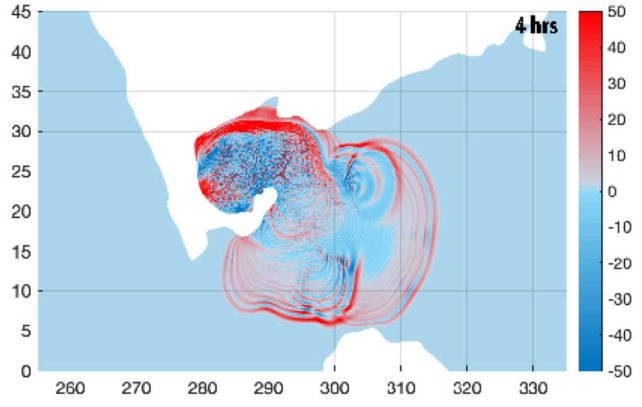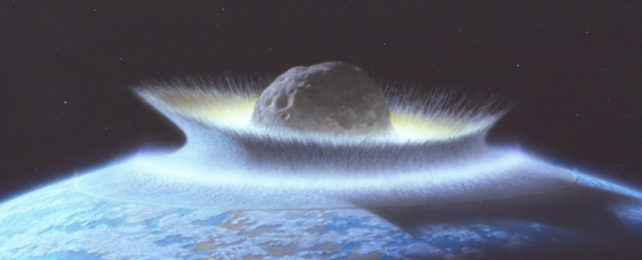The asteroid that pummeled Earth 66 million years ago transformed life on this watery planet, decimating the dinosaurs and bringing on a new era in biology.
The asteroid also created a monstrous tsunami thousands of times bigger than any wave ever witnessed in humanity's blip of existence, according to new research.
The Chicxulub asteroid, as it is now known, came all the way from the outer reaches of the Solar System, slamming into the shallow sea near the Yucatan Peninsula of modern-day Mexico.
The splashdown alone was powerful enough to leave a signature into the face of the planet. In 2021, researchers discovered that its waves had carved 'megaripples' into Earth's crust below what is now central Louisiana.
Now a new study, led by paleoceanographer Molly Range of the University of Michigan, suggests the Chicxulub asteroid thrust up a tsunami so energetic it scoured the seafloor and eroded sediments half a world away. It also dwarfs all tsunamis in recorded history, in energy and size.
The team modeled the first 10 minutes after impact and the subsequent ripple effects through the world's oceans in what is the first global simulation of the tsunami raised by the Chicxulub asteroid.
Refining simulations first presented at an earth science conference in 2018, modeling showed the asteroid generated waves up to 30,000 times more energetic than the Indian Ocean tsunami that struck Indonesia in 2004, one of the largest tsunamis ever recorded.
The initial blast from the Chicxulub impact displaced so much water it generated a wave roughly 1.5 kilometers (0.9 miles) high. All of that space didn't remain empty for long, with the ocean gushing back in to fill the gaping crater, only to ricochet off its rim and create yet more waves.
From there, tsunami waves over 10 meters (33 feet) tall traveled through the deep ocean at 1 meter per second to lash at coastlines around the world.
"This tsunami was strong enough to disturb and erode sediments in ocean basins halfway around the globe, leaving either a gap in the sedimentary records or a jumble of older sediments," says Range.
The largest and fastest moving waves were generated near the point of impact in the open waters of the Gulf of Mexico, rising more than 100 meters (328 feet) tall and moving at over 100 meters per second.
Earthquakes and underwater landslides in this region could have also contributed to tsunami formation, the researchers add.

You would think such a calamitous event would leave scars all over Earth, but scientists can only work with what they find.
Now knowing how the tsunami ripped around the world, scientists can glean details from sediments at sites far afield from the Chicxulub crater in Yucatan Peninsula to detect more fingerprints of the tsunami.
This is important in light of the mountains of research it has taken to iron out all the wrinkles in the impact extinction theory describing how dinosaur biodiversity declined.
Already, the study provides a fresh perspective on a cataclysmic part of Earth's history.
To generate the frightening figures of the tsunami's energy, height, and range, the researchers used bathymetry data estimating where the seafloor lay some 66 million years ago. While the coarse resolution of the models couldn't capture the shorelines of ancient continents, there was little doubting how impressive the surge of water would have been.
"Depending on the geometries of the coast and the advancing waves, most coastal regions would be inundated and eroded to some extent," the researchers surmise.
"Any historically documented tsunamis pale in comparison with such global impact."
They also showed that at many sites in tsunami's path, the geological boundary scientists now use to define the dinosaur extinction event was disturbed by the pounding waves.
Core samples had gaps, slumps, and truncations in the rock sections – which in some cases, geologists have mistaken for local tectonic activity that occurred at a later date.
The greatest geological disturbance was found in the North Atlantic and the South Pacific, where the tsunami waves moved faster than 20 centimeters per second.
"The most telling confirmation of the global significance of the impact tsunami is the highly disturbed and incomplete sections on the eastern shores of North and South Islands of New Zealand," Range and colleagues write.
"These sites lie directly in the path of the tsunami propagation, more than 12,000 kilometers [7,500 miles] distant from the impact location."
In their next phase of work, the researchers plan to look at how the Chicxulub asteroid may have caused a sequence of tsunamis around the world pushed forth by massive atmospheric shockwaves.
In the wake of the Tonga volcanic eruption earlier this year, scientists realized how powerful these air pressure waves could be, generating waves up to one meter high in some parts of the Pacific Ocean.
The study was published in AGU Advances.
